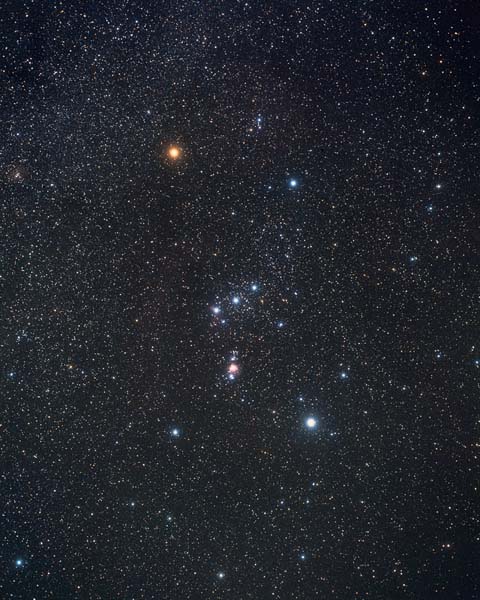DMI image reference Ori. « Previous || Next » Constellations A » H || Constellations I » V

Roll mouse over picture to see constellation outlines
Image and text ©2008 Akira Fujii/David Malin Images.
In the picture above north is at the top and the image covers 29.6 x 37.0 degrees.
Image centre is located at 05:34:09.0, +0:51:39 (H:M:S, D:M:S, J2000) Astrometric data from Astrometry.net.
Best seen in the early evening in January
Orion the Hunter is one of the most familar and best known constellations. There is extensive and varied mythology about this beautiful collection of stars, but the most common Greek legend has Orion as a giant huntsman, and he appears in this role in Homer's Odyessy. The most persistent legend seems to be that he died from the sting of a giant scorpion, which was placed in the sky so that Orion sets as the Scorpius rises, in an eternal chase across the sky.
The momorable outline of the Hunter proudly bestrides the celestial equator and is equally visible from both hemispheres. The distinctive, equally spaced line of stars of Orion's Belt are more or less on the equator and are framed by quartet of bright and colourful stars. More subtle is Orions short sword, hanging from his belt. Under dark skies or in binoculars the central 'star' is distinctly misty. This is the famous Orion nebula, one of many well known telescopic objects that fill this part of the sky.
The westernmost Orion Belt star delta Orionis (Minkata) is about a quarter of a degree of arc south of the celestial equator and all three belt stars are within 2 degrees of it. This means they rise and set due east or west of the observer and track the equator across the sky during the night, tracing straight lines as seen in this star trail photograph made from Siding Spring in Australia. Note that Orion is upside down as seen from the southern hemisphere, where it is often called 'the saucepan', with the Belt stars forming the base and the Sword stars the handle.
Main named stars in Orion: (Greek alphabet)
Alnilam (ε Ori), Alnitak (ζ Ori), Bellatrix (γ Ori), Betelgeuse (α Ori), Meissa (λ Ori), Mintaka (δ Ori), Nair al Saif (ι Ori), Rigel (β Ori), Saiph (κ Ori).
Constellations adjoining Orion: Eridanus, Gemini, Lepus, Monoceros, Taurus.
Related images (See also under 'Related Images' on pages the below)
AAT 19. NGC 1976, M42 and M43, the Orion nebula
AAT 29. The Trapezium stars in the Orion nebula
AAT 34. The NGC 1973, 75, 77 reflection nebula in Orion
AAT 36. NGC 2023 and the Horsehead nebula
AAT 94. The Red Rectangle
AAT 19. NGC 1976, M42 and M43, the Orion nebula
UKS 1. The Horsehead nebula in Orion
UKS 8. Wide angle view of the Orion nebula
UKS 23. The Horsehead and Orion nebulae
UKS 25. A reflection of the Orion nebula
MISC 11. The star colours of Orion, step-focus technique.
MISC 12. Orion rising over Conabarabran.